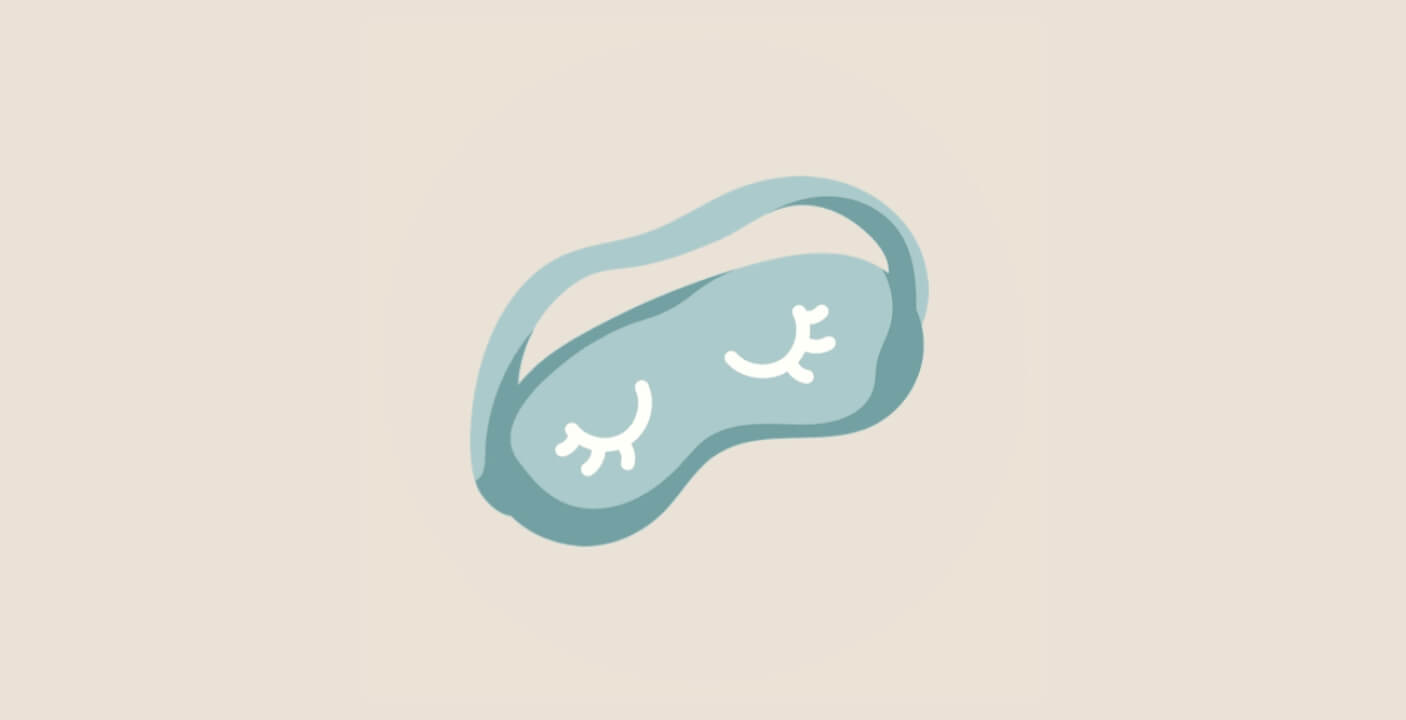
But to get to that point, we need to go through each of the sleep phases. We can break down the stages of sleep into two main categories: REM (rapid eye movement) and NREM sleep (non-rapid eye movement).
This article explains the different sleep cycle stages, how they work, and why they matter.
Stages of Sleep: How Long Is a Sleep or REM Cycle?
A complete sleep cycle lasts about 90 to 110 minutes. You’ll go through three stages of Non-REM sleep and, finally, REM sleep1.
What is REM?
Known as ‘rapid eye movement’, because your eyes dart in different directions while closed, this form of sleep usually starts about 90 minutes into a cycle. REM cycles are associated with higher levels of brain activity, and dreaming1.
NREM sleep, meanwhile, makes up about 75% of your total sleep time – and consists of progressively deeper stages of sleep.
Once you’ve completed an entire sleep cycle, you’ll start again at stage one and repeat until you wake up1.
Here are the stages of sleep in a typical, full cycle:
Stage 1
The first stage of a natural sleep cycle lasts for five to 10 minutes. During this1:
- Your body starts to slow down ready for sleep, decreasing your eye movement and muscle activity
- Your eyes stay closed
- You are easy to wake, but may feel as if you haven’t slept at all if you do wake up
- You may feel like you’re starting to fall – and then experience a sudden muscle contraction. Healthcare providers call this ‘hypnic myoclonic’ or ‘hypnic jerk’. It’s completely normal and not anything to be concerned about, as this occurrence is unlikely to cause any complications or side effects
Stage 2
The first two sleep phases are typically considered light sleep. You’ll spend around half the night in stage two. This acts as an extension of the first stage of your natural sleep cycle, and your breathing, eye movement, heartbeat and muscle activity will continue to slow down3.
Your body temperature will also start to fall during stage two sleep3.
Sleep spindles3
During stage two, you may experience what’s known as ‘sleep spindles’. These are short bursts of brain activity that occur every three to six seconds and last just 0.5 seconds each time. They are thought to block out external stimuli which might otherwise cause you to wake up.
K-Complexes3
Like sleep spindles, K-Complexes are short, sudden peaks of brain activity that help block out triggers which would otherwise cause us to wake.
Stage 3
By stage three, you’re starting to enter deeper sleep. This is where our brain activity slows down, and we become difficult to wake up. It’s also where our bodies get to work doing all the important stuff they can’t do while we’re awake. For example3:
- Releasing growth hormones
- Tissue, muscle and bone repair
- Glucose regulation
- Immune system support
- Memory processing
Stage 4 - REM Sleep
REM is the fourth and final stage of the sleep cycle. You’ll typically enter REM sleep about an hour and a half after hitting your bed. The first round of REM in a night lasts about 10 minutes, with the stage getting longer and longer each time you enter REM in one night1.
It’s also the deepest stage of sleep, where you’ll experience1:
- Quickened breathing
- Faster heart rate and blood pressure
- Rapid eye movement – hence the name!
Interestingly, we actually need different amounts of REM sleep at different stages in our lives. For example, people typically need1:
- More REM sleep during infancy, and early childhood
- Less during adolescence, and young adulthood
- Even less as we reach retirement age
It was traditionally thought that REM was the only stage of sleep where we were able to dream3. However, research has shown that we can dream at every stage4.
Light Sleep vs. Deep Sleep
While the first two stages of the sleep-wake cycle are classed as light sleep, the third stage is much deeper1.
Deep sleep is sometimes known as ‘slow-wave sleep’ because of the long, slow delta waves produced by our brains during these final two sleep stages5.
You’ll usually enter the third stage within an hour of falling asleep. If you wake up at this point, you’re more likely to feel groggy for around an hour afterwards5.
By contrast, during light sleep stages we are much easier to wake up.
Benefits of Sleep
Sleep cycles are an essential part of a healthy sleep pattern, and have many benefits. Some of these include:
- Better mood - a lack of REM sleep can potentially lead to reduced concentration and excessive sleeplessness during the day, while getting the right amount can leave us feeling more well-adjusted4
- Regulate hormones – sleep plays a huge part in balancing the levels of melatonin, cortisol and essential growth hormones that keep our body functioning6
- Protects against illness – non-REM sleep helps boost and regulate our immune system, giving our bodies the strength to fight against infection and other illnesses1
- Memory consolidation - during REM, your brain can process new information and motor skills you’ve picked up during the day. It will then commit some of this to memory, work to maintain others, and decide which ones you no longer need4
How to get a better night’s sleep
If you’re struggling to get the sleep you need, there are multiple, small changes you can make to your lifestyle that might help improve your resting hours. You should also talk to your doctor if you have any questions about your sleep.
Set a sleep schedule
Make sure you go to sleep and get up around the same time every day - even on weekends and vacations.
Clear your mind
Try to clear your head of excessive thoughts before going to bed. You could try meditating, or simply make a to-do list for the following day, so you have everything noted down and don’t have to worry about remembering everything.
Treat aches and pains
Aches and pains, especially in our backs or legs, can often stop us from getting a restful night’s sleep. Over-the-counter medication like Tylenol® PM can help relieve minor aches and pains to help you get a better night’s sleep. If pain isn’t what’s keeping you awake at night, you can try Simply Sleep®, a non-habit forming medication that helps you rest easy.
Create a good sleep environment
Are your pillows and mattress suitable for you? Making sure your bed is comfortable can be vital in helping you get a good night’s sleep. You can also create a better sleep environment by getting the lighting and temperature right for you, and taking steps to keep out loud noises.
Get plenty of exercise
Keeping active is a great way to bring on a good night’s sleep. Just avoid doing it too close to bedtime!
Cut down on caffeine
Many of us turn to caffeine to help us get through a long day, but it’s not a good idea to drink caffeine close to bedtime – as it can keep us awake.
Find more tips on how to get better sleep.FAQs
Yes. Getting enough REM sleep can help improve your mental health and emotional wellbeing7. That’s because our brains are better able to process emotions and emotional information when we’re in REM sleep7.
In most adults, REM sleep should make up roughly 20-25% of our nightly sleep cycle8. This can vary according to our age, however. For example, elderly adults may need far less.
Magnesium supplements may help improve the symptoms of sleep disorders like insomnia9. In fact, one study found that taking 500 mg of magnesium every day for eight weeks improved insomnia symptoms in older adults10.
Note that insomnia is typically diagnosed by a healthcare professional. Talk to your doctor if you have questions about what products may be right for you.
If disrupted sleep is being caused by pain, then OTC medication may help. TYLENOL® PM contains both a pain reliever and nighttime sleep aid, working fast to relieve your pain and help you fall asleep. Always be sure to use medication as directed on the packaging.
Related content
References
1. Sleep Basics. https://my.clevelandclinic.org/health/articles/12148-sleep-basics
2. The Biology of REM Sleep. https://www.ncbi.nlm.nih.gov/pmc/articles/PMC5846126/
3. What is NREM Sleep? https://www.sleepfoundation.org/stages-of-sleep/nrem-sleep
4. Siclari F, Bernardi G, Cataldi J, Tononi G. Dreaming in NREM Sleep: A HighDensity EEG Study of Slow Waves and Spindles. J Neurosci. 2018;38(43):9175-9185. doi:10.1523/ JNEUROSCI.0855-18.2018 https://pubmed.ncbi.nlm.nih.gov/30201768/
5. Deep Sleep: How Much Do You Need? https://www.sleepfoundation.org/stages-of-sleep/deep-sleep
6. What Happens When You Sleep? https://www.sleepfoundation.org/how-sleep-works/what-happens-when-you-sleep
7. Mental Health and Sleep. https://www.sleepfoundation.org/mental-health
8. Natural Patterns of Sleep. https://healthysleep.med.harvard.edu/healthy/science/what/sleep-patterns-rem-nrem
9. How Magnesium Can Help You Sleep. https://www.sleepfoundation.org/magnesium
10. The effect of magnesium supplementation on primary insomnia in elderly: A double-blind placebo-controlled clinical trial. https://pubmed.ncbi.nlm.nih.gov/23853635/






All Fields required, unless otherwise indicated
Will be used as your user name
By submitting your information above, you agree that the information you provide will be governed by our site's Privacy Policy.